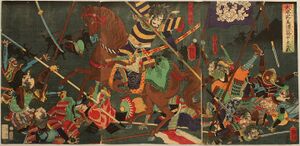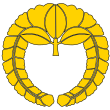Taiju War
Jump to navigation
Jump to search
| Taiju War | ||||||||
|---|---|---|---|---|---|---|---|---|
| Part of The Sengoku Period | ||||||||

|
||||||||
|
||||||||
| Belligerents | ||||||||
| Kaneitsuka clan | Muromachi clan | Sugi clan | ||||||
| Commanders and leaders | ||||||||
| Shibata Kanegetsu Kaneitsuka Yoshimitsu Kaneitsuka Yoshihisa | Muromachi Katsuyo Tachibana Josetsu Muromachi Kenchiro | Sugi Masayoshi Sugi Fumiyoshi Ogasawara Tadamasa |
||||||
| Strength | ||||||||
| 125,300 | 121,200 | 57,221 | ||||||
| Casualties and losses | ||||||||
| 17,300 | 11,400 | 8,991 | ||||||
The Taiju (大樹の乱 Taiju no Ran) was a civil war that lasted 10 years (1467–1476) during the Late Minato Shogunate in Mitoyagi, now Okaiken.[1] A dispute between Shibata Kanegetsu and Muromachi Katsuyo escalated into a nationwide war involving the and a number of daimyo in many regions of Okaiken.
The war initiated the Sengoku jidai, "the Warring States Period". This period was a long, drawn-out struggle for domination by individual daimyo, resulting in a mass power-struggle between the various houses to dominate the whole of Japan. During this long period three individuals emerged who would unite Mitoyagi under one rule; they were Ogasawara Terumasa, Takigawa Kazumasu, and Honda Shigetada.
References[edit | edit source]
| ||||||||||||||||||||||||||||||||||||||||||||||||||||||||

